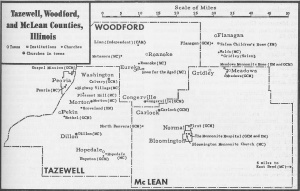Difference between revisions of "Tazewell County (Illinois)"
| [unchecked revision] | [checked revision] |
GameoAdmin (talk | contribs) (CSV import - 20130820) |
GameoAdmin (talk | contribs) (CSV import - 20130823) |
||
| Line 1: | Line 1: | ||
| − | [[File:IL_Tazewell.jpg|300px|thumb|right|''Tazewell County, | + | [[File:IL_Tazewell.jpg|300px|thumb|right|''Tazewell County, |
| − | US Census TIGER/ | + | US Census TIGER/ |
| − | Line map | + | Line map '']] [[File:ME4_689.jpg|300px|thumb|right|''Tazewell County |
| − | + | Source: Mennonite Encyclopedia p. 689'']] The first [[Amish Mennonites|Amish Mennonites]] in Tazewell County settled at Wesley City a few miles southeast of Peoria in 1831. This group met with the Black Partridge congregation in Woodford County until 1837, when Michael Moseman was ordained to lead the Wesley City congregation. This settlement developed into a strong congregation. In 1868 the congregation became a part of the "Egly" movement and is today the [[Groveland Evangelical Church (Groveland, Illinois, USA)|Groveland congregation]] of the [[Fellowship of Evangelical Churches|Evangelical Mennonite Conference]]. About 1840 other Amish Mennonite immigrants who had settled along Dillon Creek near Tremont were organized into a congregation under Bishop Andrew Ropp. This congregation was known as Pleasant Grove and today is a part of the Morton congregation. | |
| − | |||
| − | Source: Mennonite Encyclopedia p. 689 | ||
| − | |||
| − | '']] The first [[Amish Mennonites|Amish Mennonites]] in Tazewell County settled at Wesley City a few miles southeast of Peoria in 1831. This group met with the Black Partridge congregation in Woodford County until 1837, when Michael Moseman was ordained to lead the Wesley City congregation. This settlement developed into a strong congregation. In 1868 the congregation became a part of the "Egly" movement and is today the [[Groveland Evangelical Church (Groveland, Illinois, USA)|Groveland congregation]] of the [[Fellowship of Evangelical Churches|Evangelical Mennonite Conference]]. About 1840 other Amish Mennonite immigrants who had settled along Dillon Creek near Tremont were organized into a congregation under Bishop Andrew Ropp. This congregation was known as Pleasant Grove and today is a part of the Morton congregation. | ||
The first [[Mennonite Church (MC)|Mennonite]] church, as distinguished from the Amish, in Illinois was the Union Church organized near Washington. The first settlers came into the area in 1833 but apparently the church was not organized until the early 1840's. A Sunday school was organized in the Union Church around 1865, one of the first in the state. The Union Church no longer exists, most of the members having gone to the [[Metamora Mennonite Church (Metamora, Illinois, USA)|Metamora Church]] with which there had been conjoint services for many years. | The first [[Mennonite Church (MC)|Mennonite]] church, as distinguished from the Amish, in Illinois was the Union Church organized near Washington. The first settlers came into the area in 1833 but apparently the church was not organized until the early 1840's. A Sunday school was organized in the Union Church around 1865, one of the first in the state. The Union Church no longer exists, most of the members having gone to the [[Metamora Mennonite Church (Metamora, Illinois, USA)|Metamora Church]] with which there had been conjoint services for many years. | ||
Revision as of 14:21, 23 August 2013
The first Amish Mennonites in Tazewell County settled at Wesley City a few miles southeast of Peoria in 1831. This group met with the Black Partridge congregation in Woodford County until 1837, when Michael Moseman was ordained to lead the Wesley City congregation. This settlement developed into a strong congregation. In 1868 the congregation became a part of the "Egly" movement and is today the Groveland congregation of the Evangelical Mennonite Conference. About 1840 other Amish Mennonite immigrants who had settled along Dillon Creek near Tremont were organized into a congregation under Bishop Andrew Ropp. This congregation was known as Pleasant Grove and today is a part of the Morton congregation.
The first Mennonite church, as distinguished from the Amish, in Illinois was the Union Church organized near Washington. The first settlers came into the area in 1833 but apparently the church was not organized until the early 1840's. A Sunday school was organized in the Union Church around 1865, one of the first in the state. The Union Church no longer exists, most of the members having gone to the Metamora Church with which there had been conjoint services for many years.
In 1958 there were Mennonite Churches (MC) congregations at Hopedale, Morton, Dillon, Highway Village, and Pleasant Hill; General Conference Mennonite congregations at Hopedale, Pekin, and Washington; and Evangelical Mennonite congregations at Groveland and Morton (organized in 1958). There were approximately 1,700 Mennonites in Tazewell County.
| Author(s) | Tilman R Smith |
|---|---|
| Date Published | 1959 |
Cite This Article
MLA style
Smith, Tilman R. "Tazewell County (Illinois)." Global Anabaptist Mennonite Encyclopedia Online. 1959. Web. 24 Nov 2024. https://gameo.org/index.php?title=Tazewell_County_(Illinois)&oldid=93689.
APA style
Smith, Tilman R. (1959). Tazewell County (Illinois). Global Anabaptist Mennonite Encyclopedia Online. Retrieved 24 November 2024, from https://gameo.org/index.php?title=Tazewell_County_(Illinois)&oldid=93689.
Adapted by permission of Herald Press, Harrisonburg, Virginia, from Mennonite Encyclopedia, Vol. 4, p. 689. All rights reserved.
©1996-2024 by the Global Anabaptist Mennonite Encyclopedia Online. All rights reserved.


